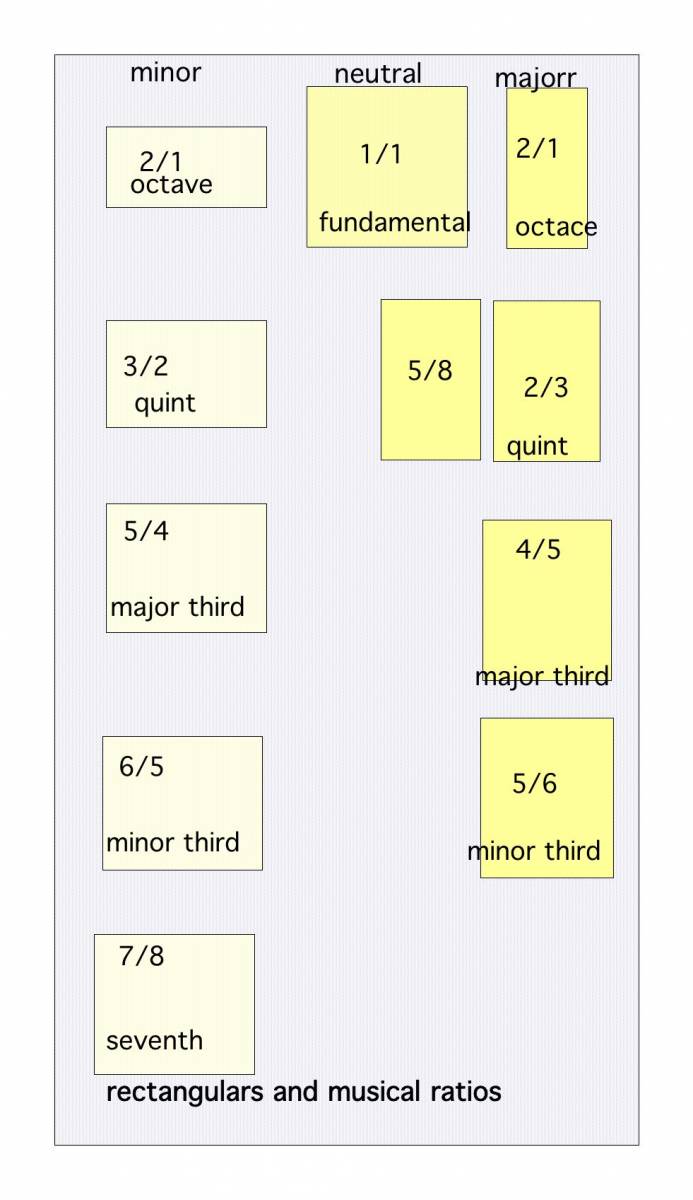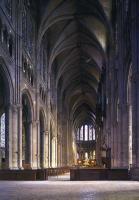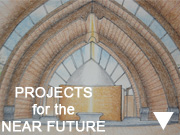:
Let‘s have a look on what the music theory can tell us about ratios to integrate this knowledge into architecture.
 The picture above shows rectangles in the proportions of the respective musical chords.
The picture above shows rectangles in the proportions of the respective musical chords.
The fifth corresponds to the golden ratio. But as you can see, there are other ratios, matching euphonious chords.
The octave ratio of 1/2 corresponds to the rectangle of Horus , used in ancient Egypt .
The ratios are always based on whole numbers. In Eastern music you will hear quarter tones, which let it sound much richer.
One might think that working with ratios of whole numbers is a limitation that one impose on himself. Yet it is amazing that by singing overtones the produced harmonics precisely are harmonics with those ratios. By changing the resonant cavities of the mouth you can create more than one pitch at the same time: the fundamental and a overtone. The first in this way created sound is an octave higher than the fundamental, then you produce a fifth, then an octave, then a major third, a fifth, a minor seventh, and so on.

A melody is formed by the sequence of these intervals . When we convert these ratios into forms such as in the attached drawing, we have a notion of how we can translate music into a design.In the Renaissance buildings one can discover for instance windows with a height of 2 x the width. This is the octave ratio. Obviously the golden ratio 2/3 or 5/8 also is used widely.
The octave ratio and the golden one are both 'restful' ratios, used for stately façades.
 Similarly, Louis Charpentier points us to the vertical structure of the inner walls of the Cathedral of Chartres according to musical ratios, such as the major third.
Similarly, Louis Charpentier points us to the vertical structure of the inner walls of the Cathedral of Chartres according to musical ratios, such as the major third.
(ill.Chartres Cathedral, )
Other musical ratios can be used. So the 4/7 for instance has his musical equivalent of the small seventh (C/ B flat or c / b). It sounds mystical. This ratio is found also in buildings for instance in the Gothic cathedral of Tours. There are seven niches in the wall of the vessel and 4 on the 2 towers next to it.
Apparently these things were known in the past. At the present time we rather make syntheses, so connections between different disciplines come back into focus. By giving these reflections I stated that the harmony rules of music are also useful in architecture, a track which can be important in the search for a more conscious architecture.
"Let us build altars to the Beautiful Necessity" writes Emerson
 The picture above shows rectangles in the proportions of the respective musical chords.
The picture above shows rectangles in the proportions of the respective musical chords.The fifth corresponds to the golden ratio. But as you can see, there are other ratios, matching euphonious chords.
The octave ratio of 1/2 corresponds to the rectangle of Horus , used in ancient Egypt .
The ratios are always based on whole numbers. In Eastern music you will hear quarter tones, which let it sound much richer.
One might think that working with ratios of whole numbers is a limitation that one impose on himself. Yet it is amazing that by singing overtones the produced harmonics precisely are harmonics with those ratios. By changing the resonant cavities of the mouth you can create more than one pitch at the same time: the fundamental and a overtone. The first in this way created sound is an octave higher than the fundamental, then you produce a fifth, then an octave, then a major third, a fifth, a minor seventh, and so on.

A melody is formed by the sequence of these intervals . When we convert these ratios into forms such as in the attached drawing, we have a notion of how we can translate music into a design.In the Renaissance buildings one can discover for instance windows with a height of 2 x the width. This is the octave ratio. Obviously the golden ratio 2/3 or 5/8 also is used widely.
The octave ratio and the golden one are both 'restful' ratios, used for stately façades.

(ill.Chartres Cathedral, )
Other musical ratios can be used. So the 4/7 for instance has his musical equivalent of the small seventh (C/ B flat or c / b). It sounds mystical. This ratio is found also in buildings for instance in the Gothic cathedral of Tours. There are seven niches in the wall of the vessel and 4 on the 2 towers next to it.
Apparently these things were known in the past. At the present time we rather make syntheses, so connections between different disciplines come back into focus. By giving these reflections I stated that the harmony rules of music are also useful in architecture, a track which can be important in the search for a more conscious architecture.
"Let us build altars to the Beautiful Necessity" writes Emerson




